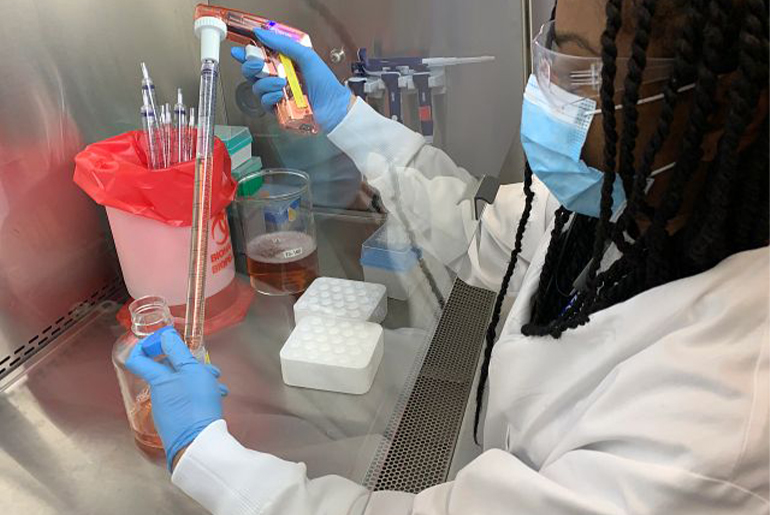While the Covid-19 virus was knocking the world off balance, scientists, production experts, office managers, logistics personnel and others at Regeneron Pharmaceuticals Inc. in Tarrytown were gearing up in a monumental effort to find a therapy that could save lives.
Regeneron had the financial as well as human resources needed for such an effort, having reported more than $6.55 billion in revenues and more than $2.11 billion in net income to the U.S. Securities and Exchange Commission for 2019.
What resulted from Regeneron’s effort — the drug REGEN-COV, also called as the Regeneron cocktail — combines two monoclonal antibodies to attack SARS-CoV-2, as Covid-19 is formally known. It’s one of the drugs that Donald J. Trump received while he was president, which some experts believe may have helped save his life after he became ill and had to be helicoptered to Walter Reed National Military Medical Center in Bethesda, Maryland. REGEN-COV has been demonstrated to prevent the hospitalization and death of Covid-19 patients. The U.S. Food and Drug Administration (FDA) gave it Emergency Use Authorization, subsequently modifying that to allow for the drug to be injected as well as infused. The FDA also allowed cutting the required dose in half to 1,200 milligrams, because it works so well.
This is not the first time Regeneron has responded successfully to a virus crisis. It created the drug Inmazeb to treat the deadly Ebola virus. Inmazeb is a mixture of three monoclonal antibodies that were created using Regeneron’s technique of engineering the immune systems of mice to simulate the human immune system and generate human-like antibodies to fight invading diseases.
Inmazeb targets a glycoprotein on the surface of Ebola and blocks the virus from attaching to human cells, a necessary step for the virus to get inside and kill the human cells. Clinical trials, including use during Ebola outbreaks in Guinea in 2014 through 2016 and the Democratic Republic of the Congo in 2018 and 2019, showed that the therapy worked, leading the FDA to designate the drug as a Breakthrough Therapy that would ultimately become the first FDA-approved treatment for Zaire Ebola virus in pediatric and adult patients. The immediate thought echoing through the more than one million square feet of space at Regeneron’s main campus was, if the principle works against Ebola, wouldn’t it also work against Covid-19?
“We did a bit of work on MERS (Middle East Respiratory Syndrome a coronavirus that was first reported in Saudi Arabia in 2012) so there was experience with coronavirus research,” Alina Baum, associate director for infectious diseases at Regeneron, tells WAG. “We started hearing these stories coming out of China — it was maybe late December — of just some kind of new respiratory virus. In the beginning of January, our government partners shared the sequence . . .of the spike protein.”
Spike proteins are on the surface of the Covid-19 virus and, like the proteins on the surface of Ebola, provide a mechanism for the virus to latch onto human cells and proceed to invade.
“Because we have this history of working on emerging infections with MERS, Ebola, Zika (a virus transmitted by mosquitoes) there was really no discussion of whether we should do this or not,” Baum says. “It was almost a no-brainer for us. There’s a new virus and we had the sequence, which is the key to begin the actual work. We were going to start working on it.”
Baum recalls that what happened from Jan. 13, 2020, when Regeneron got the genetic sequence, to the end of that month was that the urgency increased almost exponentially.
“It went from ‘we might as well work on this and get some antibodies’ to ‘oh my God, this is going to be a really big problem. It’s going to be a global problem. We need to move as fast as humanly possible to isolate antibodies and try to move into the clinical development,’” Baum recalls. “We had the capability, and we had this commitment to addressing emerging infections.”
Baum says people involved in infectious disease work at the company were pulled from other projects to concentrate on Covid-19. Sixteen-hour days, seven days a week became the norm in the first couple of months.
“This was a brand-new virus, which means there are no systems; there are no reagents (compounds that can cause a chemical reaction or are used for chemical analysis); there’s nothing that’s already there that you can use so everything has to be developed from scratch,” Baum says. “In order to get the antibodies eventually to move into the clinic, you have to be able to not only immunize the mice but you have to be able to get the right cells from the mice. We’ve done this many times before. We know how to utilize our humanized mice and get the antibodies that we want from them and we know how to make antibodies that target a virus. We have a lot of virology experience. It was really a straightforward decision and a straightforward plan of how to do this because of all the experience that Regeneron has in other antiviral programs.”

But this was now a “rocket speed” program, Baum says:
“All the different groups come together and this becomes the number-one priority. What that allows you to do is to move very rapidly in a way that’s very coordinated and all the groups know exactly what their part of the job is and everything comes together in almost a seamless way. There is no confusion and there are not a ton of decisions that need to be made in terms of who is going to do what because it’s all laid out from our previous experience.”
And that previous experience told the Regeneron team that equally important would be protecting itself for the work ahead. As Elizabeth Green, Regeneron’s senior director for environment, health and safety, adds: “It was in early- to mid-January when I heard from a colleague that the N95 (protective mask) in all of China was sold out and they were just not available anymore. I thought about personal protective equipment for our staff and the different groups that needed N95s, for example. We got ahead of it as much as we could by identifying it early-on as a supply chain issue and identifying what we needed to protect our people in day-to-day operations.”
She says that before New York state had enacted the pause in business and people were switching to working from home, Regeneron started to establish protocols such as no international travel and parameters for when to self-quarantine. The company developed four guiding principles.
“The first was a matter of protecting the health and safety needs of our employees,” Green says. “The second was using data and science to guide our decisions. The third one was schedule return to site that was in alignment with business needs. The last one was regular communication, evaluation and feedback.”
Green says that the company’s scientists, physicians, attorneys, human resources personnel and all levels of management across the business were represented in the decision-making on how to adapt to the unfolding situation.
“Even though I might have been orchestrating a lot of the groups and the coordination of effort, it took so many people’s expertise to be as successful as we so far have been,” she adds. “To see the spirit of the organization was just outstanding.”
One of the phrases used within the company to express its philosophy is “be great together,” Green says:
“It was extremely unprecedented and challenging. However, we instilled the confidence that everyone’s health and safety was paramount and that in itself helped with change management. We really did things to walk the walk and to prove it. That enabled the confidence to adapt to the change. I and my team were heavily involved in bringing the different subject matter experts together…and identifying what do we anticipate could happen and then start planning and having different options and be able to be flexible and pivot as we needed to.”
Green says that by mid-March, only about 500 of the approximately 3,500 staffers were reporting for work at the Tarrytown campus, with numerous employees working off-site. The number was gradually increased to about 1,900, with safety protocols strictly observed. Even with the concentration on Covid, Regeneron’s other activities continued, including more than 30 clinical trials.
When the first set of clinical data came in showing that Regeneron’s monoclonal antibody cocktail did, indeed knock down the viral load in treated individuals, the scientists became convinced they had something that was promising, Green says. But they didn’t get overconfident. When the company and FDA authorized the use of the still-experimental cocktail to treat Trump, she adds, the scientists’ interest remained focused on clinical trial data rather than an anecdotal event.
“As scientists, all of us realize that an anecdotal experience from one individual is just that. It’s definitely interesting to people, but overall the data that’s coming from the actual controlled clinical trial is much more meaningful than something like that, because that’s what convinces us that we have a drug that’s actually doing something and helping people,” Baum adds. “I would say it was definitely a very interesting experience to have, but that wasn’t the moment that made us say, ‘oh wow, we have something that works.’”
She thinks it’s unlikely that Covid-19 will go away, even with higher herd immunity and an increase in vaccinations, adding that as a society we are very much underutilizing antiviral therapies such as Regeneron’s REGEN-COV for acute infections.
As Baum put it: “If we had 500 people dying of some kind of a cancer every day and we knew we had something we could give them to protect from that outcome, would we even think about that twice?”
For more, visit regeneron.com.

